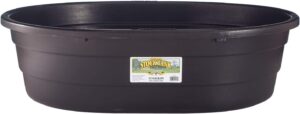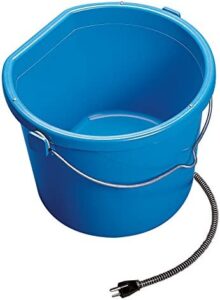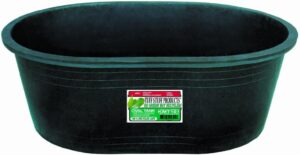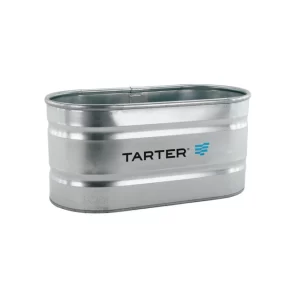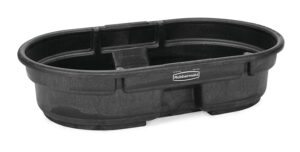Posts may contain affiliate links and/or sponsored products. See our Disclosure.
Keeping your horse hydrated is incredibly important for their health. Not only does it help to prevent colic; good hydration is also essential to support their bodies. Providing fresh, clean water is a good way to encourage your horse to drink.
Water troughs are a common way horse owners provide water to their horses and they come in many shapes, sizes, and materials to meet the needs of the barn. Selecting the right water trough for your barn and horse is just as important as regular maintenance to ensure your horse has access to clean water all of the time.
Many horse owners will choose water troughs instead of automatic waterers so they can monitor how much their horse is drinking and take note of any potential issues. Since water troughs come in various sizes, they also work well for groups of horses during turnout.
Unlike 5 gallon buckets, water troughs generally hold more water and do not need to be filled as frequently. This is a serious consideration during hot conditions and if you are not able to monitor water consumption all day long.
Another huge benefit of water troughs for horse owners is they are inexpensive. Most water troughs cost less than $200 and, if well maintained, will last for many years. They are also available at almost every local feed store, making them very accessible and easy to start watering your horse quickly.
What Kind of Water Trough is Right for Your Horse?
Water troughs come in four basic materials—plastic, galvanized and non-galvanized metal, and bathtub material. There are pros and cons for each of these materials that are important to know before making a purchase.
What to Look For in a Horse Water Trough
Size: There are several things to consider when you are looking for a horse water trough. First, consider where you are going to place the water trough. Is the area large or small? This will determine the size and shape you need. For example, you would not purchase a 50-gallon water trough for a 12’ x 12’ stall. However, a 50-gallon water trough could be the perfect choice for a paddock.
Shape: Water troughs also come in many different shapes—oval, round, and corner. Corner shapes are ideal for stall placement as they don’t use up as much of the stall floor space. Round and oval water troughs are best suited for paddocks or turnout areas as there are multiple access sides if you have several horses trying to drink at one time.
Material: Plastic or poly water troughs tend to be the most common choice for horse owners. They are lightweight and easy to install and move. However, they are not as strong as the metal alternative. If you have a horse that likes to swim or play in the water trough, a plastic trough is unlikely to hold up to this.
Plastic troughs are made from food-grade polyethylene for the purest quality water and have UV protection to prevent the plastic from becoming brittle in the sun. Additionally, plastic is less conductive of heat, resulting in cooler water temperatures.
Metal water troughs have pros and cons, too. Metal water troughs are stronger than plastic water troughs, but require special care to maintain. They are unlikely to crack or break and generally will dent under impact. Metal water troughs are susceptible to rust and corrosion, a constant problem that eats away at the metal and can contaminate the water.
Regular cleaning and inspection of metal water tanks is an excellent way to prevent rust and corrosion. Metal stock tanks are generally not recommended in hotter areas, because metal conducts heat, making the water very hot, very quickly.
Many water troughs come with or have the ability to add a water heater. A properly installed and maintained water heater is an excellent tool for cold winters. This prevents the ice from accumulating at the top of the water, allowing your horse to drink freely.
If you live in an area where water buckets freeze in the winter, consider purchasing a water trough with a water heater. When adding a heater to an existing water trough, be sure to get the appropriate size for your tank.
Top Ten Horse Water Troughs
There are a lot of great stall troughs and livestock tanks on the market today. The following are our favorites, listed according to stall/run use and pasture use.
5 Best Water Troughs for Stalls and Runs
1. Harris Farms Heated Trough – This heated trough holds about 16 gallons and is ideally shaped for most stalls. The built-in heater is a great feature for farms that experience freezing winter months.
2. Little Giant Oval Tank – This 15-gallon plastic tank might be a bit large for a smaller stall, but has a nice large capacity for horses that drink a lot of water.
3. Little Giant 4-Gallon Tank – This little water trough is a bit of a cross over between an automatic waterer and a water trough. You hook up a hose and the waterer is filled through a float system. This is a nice way to test automatic waterer functionality without the high cost.
4. Little Giant Plastic Animal Feed Bucket – For smaller stalls with no floor space to spare, this smart bucket could be a good option. It has a soft grip for carrying and has a 20 qt. capacity.
You can also get a heated version!
5. High Country Plastic Tank – This 15-gallon tank is a nice choice for stalls. The oval shape makes it easy to push against a stall wall to preserve floor space.
5 Best Water Troughs for Pastures
1. Tuff Stuff 40 Gallon Tank – This oval tank is a good size and shape for a small paddock. The material is very flexible if your horse likes to play in the water trough.
2. Tarter 100 Gallon Tank – This galvanized tank will stand up to the roughest pasture play and is large enough for several horses in turnout.
3. Rubbermaid 100 Gallon Tank – If you are looking for a bigger tank, but don’t want to deal with the weight of a galvanized tank, this is the tank for you. The oval shape is perfect for allowing several horses to drink at one time.
4. Rubbermaid Foam Stock Tank – This 50-gallon plastic water trough is light and easy to move around as needed. It works well for one or two horses during turnout, but will require frequent refilling for a bigger group of horses.
5. Behlen Steel Round Tank – This monster tank has a 340-gallon capacity and is designed for watering herds. The round shape gives full access to numerous horses without causing an issue.
You can also opt for the 78-Gallon alternative.
Troughs vs. Automatic Waterers
Horse water troughs are a convenient, inexpensive way of watering your horse. However, some horse owners opt for an automatic waterer so they do not have to manually refill water troughs.
In general, an automatic water trough costs between $50-$350, plus installation, which is more expensive than a water trough. While they are a more expensive option, the convenience for some horse owners is worth the extra cost. Automatic waterers do require semi-annual maintenance and regular cleaning.
Some horses prefer automatic waterers to troughs because the water is always cool. If your horse is particular about water temperature, an automatic waterer could be the ideal option.
Troughs vs. Natural Water Sources
If your horse is in a pasture with a natural water source like a lake or stream, it can be tempting to use this for watering your horse. While these natural water sources can be excellent as a backup water source, many water sources in livestock pastures are contaminated by manure and urine. A water trough is a safer way to guarantee your horse has access to fresh water.
How Much Water do Horses Drink During the Day?
An average horse drinks about 7-10 gallons of water per day. Very active horses, broodmares, or lactating mares will require more daily water intake. You may notice a difference in water intake for your horse from summer to winter because of water temperature.
While most of us don’t enjoy freezing water, it is important to encourage your horse to drink during the winter months to prevent impaction colic. You can encourage them to drink by heating the water slightly or by adding a bit of electrolytes.
A nice feature of water troughs is you can monitor exactly how much your horse is drinking. This allows you to quickly notice if your horse is not drinking enough and be on alert for signs of dehydration. Signs of dehydration would include lethargy, lack of urination, and colic.
A pinch test is a quick way to determine your horse’s hydration level. Pinch a portion of skin on your horse’s neck between your thumb and pointer finger, the skin will tent between your fingers. Release the pinch and see how quickly the skin moves back into place. The skin should drop back into place very quickly. If it takes more than a second or two, your horse is likely dehydrated.
Pros and Cons of Goldfish in a Water Trough
Goldfish can actually keep your horses’ water trough clean and live off of the algae growing on the walls and floor of the trough. They will even eat mosquito larvae and insects in the water.
If you are going to try goldfish in your water trough, there are a few things to know. Two fish per 55-gallon tank is generally plenty. If you add too many fish to the tank, the ammonia will build-up, which deters most horses from drinking.
Next, remember not to feed the fish. If you feed them they will be less likely to eat the algae, larvae, and bugs. For tanks in full sun, consider adding bricks or larger rocks to the bottom of the tank to provide shade for the fish.
Just as fish are not tolerant of high temperatures, most are not tolerant of very cold temperatures. Bring your fish inside during the winter months to ensure they survive. You can put them back in the tank when the water is about 60 degrees Fahrenheit.
Read more about goldfish in water troughs here.
Maintaining Your Horse Water Trough
Proper maintenance of your water trough will not only extend its usable life but also ensure your horse is drinking clean, fresh water. You should empty, scrub, and spray out your horse water trough at least once per week. This will help prevent algae from growing and contaminating your horse’s water. Refill the tank to just below the top when adding water back in.
If you are able to rinse out your horse’s water trough and refill daily, that is ideal. However, most people aren’t able to do this on a daily basis. In lieu of that, run the hose at the bottom of the tank and allow the water to run over and out of the tank for a few minutes. This helps to stir up the sediment on the bottom of the tank and flush it out. Don’t run the water for too long or you will end up dealing with mud around your tank.
There are numerous water-borne illnesses that horses can contract by drinking contaminated water, including Cryptosporidiosis, Giardiasis, and Leptospirosis. All of these illnesses are very dangerous and potentially fatal for horses. This is why proper cleaning and maintenance of your horse’s water trough is so important.
A hint with preventing algae in your tank – place your tank in the shade whenever possible. This not only helps prevent algae, which needs sunlight to grow but also keeps the water cooler for your horse!
Horse Water Trough Safety
Safety is our top priority as horse owners. When choosing and installing a horse water trough make sure to consider your horse’s safety. Install the water trough in a safe area where your horse cannot get stuck in or around the trough. Some horses like to play in the water, if this is the case for your horse, consider a shorter tank to ensure they don’t hurt their legs. Or, install a water trough that is out of reach for their legs.
How to Deal With Troughs in Freezing Weather
Freezing water tanks is an annoying and all too real reality for horse owners. Prevention with a water heater is always the easiest option for water tanks. If you are not able to install a water heater, pick up a rubber mallet to break the top layer of ice and a strainer to scoop out the ice pieces. Generally, once a hole is opened, your horse’s continued drinking will keep the water from freezing quickly.
Frequently Asked Questions:
- How much does a water trough for horses cost?
Horse water troughs can cost between $40-$500 depending on material and size.
- How often should I clean my horse’s water trough?
Depending on the size of your water trough, you want to empty and clean it once per week. Make sure to monitor for algae in between cleanings. If you see algae sooner than your once per week cleaning, you should clean it more often.
- What is the best horse water trough?
The best horse water trough will vary for everyone, depending on how their horse lives, how active they are, and the weather. See our top ten recommendations above!
- How big should a horse’s water trough be?
To determine the best size horse water trough, consider how frequently you can fill it and how many horses will be drinking from it. If each horse drinks roughly 10 gallons per day and you have 3 horses in the pasture, you want a 30-40 gallon tank minimum for one day of watering.
- How much water does a horse drink in one day?
An average horse will drink about 10 gallons of water per day. This amount will go up for broodmares, lactating mares, or very active horses. This will also fluctuate depending on if the weather is hot or cold.
- What can I do if my water trough freezes over?
You can chip out the ice on the top to free up access to the water underneath or you can install a water heater.
- Why do they put goldfish in horse troughs?
Goldfish are a great way to keep tanks clean because they eat algae and insects from the tank.
- How long does a horse water trough last?
Most water troughs can last at least a few years. The galvanized stock tanks can last 15+ years!
As you can see, there are lots of great horse water trough options for horse owners. Horse water troughs are inexpensive and allow you to easily monitor your horse’s daily water intake. Using the guidelines above, you can select the right style, material, and location for your horse and its lifestyle. Make sure to keep up with your maintenance and cleaning routine to ensure your horse has access to clean, fresh water year-round.





